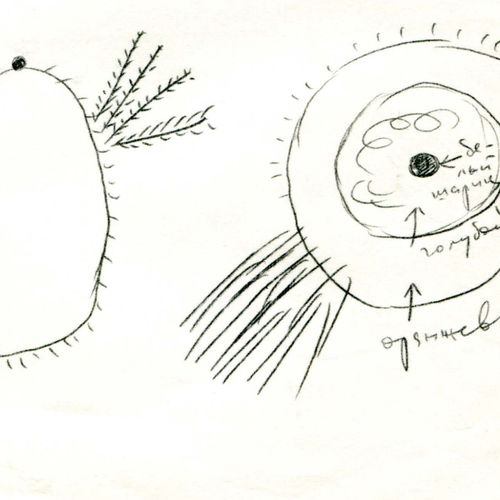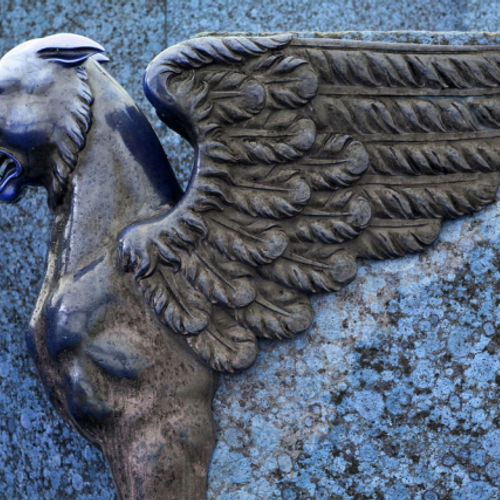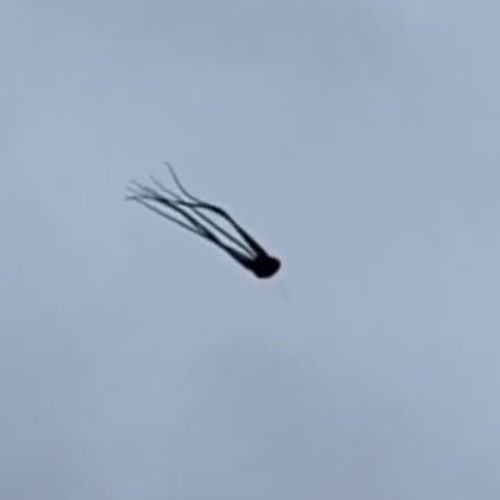| Added | Mon, 10/02/2020 |
| Hierarchy | |
| Область распространения | All over the world |
The group phenomena of uniting living beings of unknown origin who are able to fly. The witness who watches this creature in the sky, can directly interact with it and even suffer from his actions.
Translated by «Yandex.Translator»
Phenomenon in mass culture
Phenomena
Exekyu
A character of Dolgan fairy tales and the heroic epic olongko. A giant eagle with a beak capable of breaking a human skull.
He is the king of all birds. One of the legends tells about the size of the bird, where it was carried on eight horses, and in which the Exekyu swallows three cows at a time. Sometimes this mythical bird is described as two-headed (or even eight-headed).
Exekyu is also able to transform into a human and in a similar guise act as a legendary hero-king, dressed in heavy armor and with wings on his back.
Aitvaras
In Lithuanian mythology, a flying spirit in the form of a fiery serpent, a dragon, sometimes a black crow, a heron, a black or fiery rooster, less often a cat.
He flies over the trees, leaving a trail of fire. It can indicate where the treasure is buried, falling on this place in the form of a star. He can come to women and strangle them at night. Can engage in sexual intercourse with them as an incubus.
Akbuzat
Akbuzat (bask. Aҡbuҙat, tat. Akbuzat — light winged horse) — a character of Turkic folklore and mythology, the first ancestor (totemic ancestor) of the people, a heroic horse-virtue.
Amikiri
In Japanese folklore, a flying crustacean that harms mosquito and fishing nets.
Amikiri or Amikiri (あみきり is the Japanese spelling of the name Amikiri in hirakana syllabic alphabet, 網切 is the original Japanese spelling of the name Amikiri in kanji characters) it can be literally translated as "cutting nets".
They have an elongated body with a red segmented shell, a beak like a bird, and scissor claws instead of hands. In addition, they can fly through the air, swimming in it like a fish in water.
Anzud
In Sumero-Akkadian mythology, an eagle with a lion's head, the messenger of the gods. The image of Anzud is one of the most popular in Sumerian heraldry.
The first root "An-" (in the name "Anzud", "Anzu") means noise. "An" = "heaven; god of heaven"[3]. The second root "-Itch, -Zu" (and the name "Shutu", which is close to "-Itch") can be considered the proper name of this deity.
Anka
Anka (Arabic. — a character of Arab-Muslim mythology, wonderful birds created by Allah. They look like the legendary Phoenix.
At first they were created "perfect" and built their nests on Mount Kaf, somewhere in the Caucasus.
Arales
Dog-like creatures from Armenian mythology.
Յարալեզ — the original spelling of the word "Aralez" in Armenian.
These are spirits who appeared in the form of winged creatures that descended from the sky to resurrect the fallen in battles, licking their wounds.
It is believed that they are similar to gampres (a breed of wolfhounds similar to Caucasian shepherds).
Martinetas
In the Slavic mythology is the bird that knows how to change the color of Perv, and the meat of this bird does not rot and has the property to deter moles.
Translated by «Yandex.Translator»
Balaur
In Romanian mythology, a creature similar to a dragon (although dragons are also present in Romanian mythology).
It looks like a snake with wings, legs and many heads (usually three, sometimes seven or twelve) and can reach large sizes. In Romanian fairy tales, he is the personification of evil.
It is believed that the word balaur originates from the Proto-Indo-European root *bel- (strong) or * bhel- (to grow).
Biiniao
Birds that joined their wings is a literal translation from the Chinese name Biinyao. These are Chinese lovebirds.
The Biinyao were represented as a wild duck with red-green plumage. Each bird had one wing, one leg and one eye. They could fly, eat and drink only by joining together in twos. Therefore, they always flew and rested in pairs. According to some sources, one of the birds was green, the other was red.
Because of their inseparability, the biinyao were considered a symbol of a happy marriage.
Blago
In Adyghe mythology, a chthonic monster, the personification of the evil forces of nature, a dragon, throwing down water from its huge mouth, which rains, and from a distance it seems like a white cloud (fog) covering the sky. The air he exhales knocks down riders and horses, a blizzard from his eyes sweeps away everything on the way.
In legends, he blocks the river and gives water to the inhabitants, only receiving a girl from them as a tribute.
Bruja
Bruja (bruja from Spanish sorceress, witch) - a kind of witch.
In modern folklore, this is the name of a cryptid - a flying creature that lives not only in England, but also in Wales, Mexico, the USA, Canada, Scotland, Northern Ireland, Puerto Rico and Ireland.
Probably a variant spelling or a varietyBrooks
Batsquatch
A creature from the folklore of the USA. "Batsquatch" from "bat" is a bat and "sasquatch" is a North American yeti.
A flying cryptid that was supposedly spotted near Mount St. Helens in the 1980s. It resembles a flying primate.
This furry creature is said to have yellow eyes, sharp teeth, bird-like feet and leathery bat wings extending up to fifty feet (15 m).
In addition, he is said to be 9 feet (2.7 m) tall and has the ability to affect car engines.
The Wawel Dragon
The Wawel dragon or Wawel tzmok (in Polish, "smok wawelski", aka całożerca, aka holophagus - that is, a creature that swallows its victims whole, a zhivoglot) is a creature from Polish folklore that lives in a cave (called Dragon pit) at the foot Wawel Hill in Krakow.
Once a week, a cow was to be sacrificed to the dragon; if he did not receive it, he devoured people in return. On numerous monuments, he is depicted as a huge lizard-like creature with wings, spewing fire.
Raven Voronovich
In Slavic mythology, there are certain sacred ideas about crows. This is reflected primarily in fairy tales and epics.
The Harpy
A creature from Greek mythology with the face and chest of a woman and the body of a bird of prey.
Harpies (other-Greek. ἍΡπυιαι "abductors", "predators"), in ancient Greek mythology — half-women-half-birds, personifications of various aspects of the storm, archaic pre-Olympic deities.
Garuda
Garuda (Skt. गरर, IAST: GaruḍA, tib. Khyung, Mkha` lding) is a mythical king of birds in the Hindu and Buddhist traditions, half—man and half-bird.
In Hinduism, the riding bird (with a female body and head) of the god Vishnu, a fighter with naga snakes.
Hippalectrion
Hippalectryon (al-Greek. ἱππαλεκτρυών, from ἵππος — horse and ἀλεκτρυών — "rooster" in Latin. Hippalectryon) — in ancient Greek mythology, a creature with the body of a rooster and the front part of a horse.
At the moment, no myths related to the hippalectrion are known. The very first images of him currently date back to the IX century BC, become most common in the VI century, especially in vase painting, and sometimes in the form of statues, often with a horseman. The hippalectrion is also mentioned in several ancient literary works and is present on some banknotes.
Hippogriff
Hippogriff (Greek: Ἱππόγρυπας, Hippogriff, Hippogryf, Hippogryph) is a mythical creature: a half-horse is a half-gryphon (while the gryphon itself combines the features of a lion and an eagle).
He is very fast and is able to fly around the world and even to the moon.
Thunderbird
A legendary creature in the mythology of the North American Indians, possessing supernatural power. It is believed that the giant wings of this bird raise the wind and cause thunder: flapping wings - fire breaks out, flapping - thunder thunders. It is assumed that the feathers of such birds consist of metal.
Guhyaki
Half-horses are half-birds of Hindu mythology, guarding treasures. They have their own world, those who get into it experience bliss.
Guhyaka (गुह्यक) Hidden is a literal translation of the name of the Guhyaks.
Danhu
In Chinese mythology, a wonderful bird that flies with its beard (or mustache growing over its beak). Danhu meat has the ability to cure any diseases.
It is believed that the prototype of the creature was an ordinary capercaillie.
Di Jiang
In Chinese mythology, on fire flying creature in the form of a wineskin without a head, but with six legs and four wings.
Translated by «Yandex.Translator»
Dragon
A creature from the mythology of Europe and Asia in the form of a huge winged lizard-like creature.
Dragon (Greek: δράκων) — a collective name that unites a number of mythical creatures that appear in the myths and folklore of many peoples of the world.
European Dragon
Ekek
Creatures from Filipino folklore, described as winged people, or half-humans, half-birds. It is believed that it launches its proboscis into the uterus of a pregnant woman and sucks blood from an unborn child through it.
Zburator
In Romanian-Moldovan mythology creature, which looks like a flying serpent with wings. It can assume the form of men or women and come in the middle of the night to the victim and make them do obscene things. While it is not noticed by other people.
Translated by «Yandex.Translator»
Zilant
Tatar flying mythological two-headed snake: one head he had the dragons, the other cowhide. He was described as "a black crowned dragon, the wings and the tail is scarlet, the beak and claws are gold; the dark red".
Translated by «Yandex.Translator»
Irapuru
Uirapurú is one of the birds whose origin has been devoted to the legends and myths of the indigenous peoples of Brazil.
A magical red bird, a symbol of happiness. It was a young Indian whom the chief cursed because of his love for the latter's daughter. A beautiful song began. The chief heard this and went into the forest to catch the bird, getting lost forever. Irapuru is still singing, hoping that the girl he loves will recognize him.
Whoever finds this bird may have a wish come true.
Ihuayvilu
When a group of kalkus (shamans) chooses a cave for their reunions, they perform a great ritual, calling on ihuayvila to guard it. This monster is a dragon with a snake neck. He flies with the help of a strong wind and has a fiery breath that can set fire to entire fields or groves. It roars like thunder, and its passage through the air leaves a green trail.
Caladrius
A creature from Roman mythology described in medieval bestiaries. It is a snow-white bird that can take the disease into itself, and then fly away, dispelling the disease and healing both itself and the patient.
Medieval interpretations focused on the diagnostic potential of a bird: if it looks into the face of a sick person, a person will live; if she looks away, the person will die.
Kama Itachi
In Japanese folklore, a weasel with a sickle, invisibly moving on the swirling winds. They cannot be seen with the naked eye.
They travel and attack three of them: The first knocks the victim down and knocks him to the ground, The second causes thousands of terrible cuts to the lying, and the Third — applies a magic ointment to the wounds, which instantly heals most of the wounds so that none of them turns out to be fatal.
Karakosh
A character of the Turkic-Tatar mythology. It is a large black bird with a yellow beak and claws.
In Tatar fairy tales, Karakosh marries the tsar's daughter, turns into a beautiful horseman.
In the Kyrgyz and Kazakh epos there is a parallel Karakosh – a giant bird Alpkarakush, which protects the hero.
Congomato
A creature from Afrakan mythology. It is believed that it lives in the Mwinilunga region in the area of the Jindu and Bangwelu swamps in western Zambia, Angola and the Democratic Republic of the Congo.
It is described as similar to a pterodactyl. Its skin is red or black in color, with a wingspan of 4 to 7 feet (1.2 - 2.1 m). It has deep-set eyes and a large beak with a mouth full of sharp teeth.
Wind Horse
The symbol in Tibetan Buddhism is in the form of a horse carrying a chintamani on its back, that is, a jewel that fulfills desires and brings prosperity. It also denotes the life force of a person.
The coat of arms of Mongolia depicts a horse with wings that resembles a wind horse (Mong. hiy mor), which is a symbol of energy and spirit.
Critter
Quitter or Critter (from the English, creature – a creature, a creature), spontaneously appearing in a photograph of some kind, not normally visible structure, including a human face. These are mostly spheres or ovals, but a considerable part of them are completely unimaginable and creepy creatures.
Terms are also used: signature, deva, etheric being, and the like.
Kurangaituku
In Maori mythology, this is a cannibal woman of huge stature with sharp, elongated lips and large wings.
The creature has the body of a woman, and the head and wings of a bird. He is a fleet-footed, strong, flying giant. It lives in the depths of the forest, where it survives by catching birds with its beak-like lips. She eats most of them, but keeps some as pets.
Letavets
In Slavic mythology, a creature in the form of a shooting star or a bright fireball (sometimes sparkling), upon landing, takes on a human image and engages in sexual intercourse with its victims. It appears from the clouds, flies through the air, and, scattering sparks over the roof, enters the house through the chimney. It is considered the hypostasis of the walking dead or the devil.
Here is the definition of a "flyer", which was given in the XIX century in the Pokrovsky and Yuryevsky counties of the Vladimir province:
Lejak
In Balinese mythology, a demon flying at night in the form of a head with the entrails hanging down.
They usually fly in search of pregnant women to suck blood from their babies (still in the womb or recently born). They appear in cemeteries, feed on corpses, can fly and turn into different animals (most often pigs). At the same time, during the day they look like ordinary women, but with an unusually long tongue and large fangs.
Lunma
Lunma 龍馬 (lóngmǎ) is a dragon horse, one of the most famous chimerical motifs of Chinese mythology.
A visual combination of a dragon and a horse. It is described as "a winged horse covered with dragon scales that does not drown when stepping on water."
The image of lunma has spread widely in the culture of East Asia.
Mananangal
Mananangal (Manananggal translates from Tagalog roughly as "dividing") — a mythological creature in the Philippines that is identified with a wakwak.
The creature is similar to a Western vampire: it is vicious and eats people. The legend is common in the Visayas, especially in the provinces Kapis, Iloilo and Antique.
Mananangals are afraid of salt, avoid daggers, light, vinegar, spices and a whip from the tail of a stingray.
Manya
Manya, Man or A maniac in the mythology of central and southwestern Russia is a spirit that takes the form of a shooting star (or comes on it).
In different beliefs, these creatures are spoken about in completely different ways. Somewhere she foreshadows inevitable death, somewhere she appears in the yard where the girl lost her innocence, somewhere she was shown to women working in the field and in behavior she looked like a succubus or incubus (depending on gender), somewhere she looked like a shadow man, and somewhere like an old woman looking for her son.
Have Mello
In the folklore of European Roma terrible demon in the shape of a gray-headed bird, which sends people mad and thus pushes them to all sorts of crimes: robbery, murder, rape, etc. the Affected people are not able to speak, but only cry like magpies.
Translated by «Yandex.Translator»
The Crawfordsville Monster
The Monster Crawfordsville refers to the alleged creature reported by residents Crawfordsville (Indiana) in 1891. This story, "one of the most fantastic of all UFO reports," contributed to the formation of early theories about UFOs as airborne organisms.
Journal Crawfordsville described it like this:
Mayastre
A character of Romanian folklore, a fabulous bird. Wounded or captured, the magic bird takes its real form — turns into a fairy.
Nobusuma
In Japanese mythology, a creature that feeds on blood and fire in the form of a giant flying squirrel, which becomes an overly old bat. If she is not hungry, she simply swoops down on a lantern or torch to extinguish it, and then flies back into the night sky with a terrible cry of "ha-a, ha-a!"
Night mverzi
Fictional characters from the books of H. Lovecraft (1890-1937).
He writes about them like this:
Nubero
A creature from Spanish folklore (Asturian, Cantabrian and Galician mythology).
According to Asturian mythology, Nuberu is literally "Cloud Master" (English Nuberu, Nubeiro):
A long time ago, Nuberu arrived to the Asturians riding on a cloud, but he failed and fell from it to the ground[3]. After that, he asked for asylum, but no one wanted to help him, until one night a peasant took pity on him. In gratitude for the help, Nuber caused rain over his fields and gave him a good harvest.
Nukekubi
In Japanese mythology, the head of which is completely separated from the body and fly at night. Typically, a flying head, like a vampire, sucks the blood from their victims, but sometimes brutally bite people and animals to death.
Translated by «Yandex.Translator»
About-kuby
In Japanese mythology, a spirit that looks like flying in the sky a huge severed female head. Most often, they just smirked and fly in the sky and chase people, knocking down umbrellas and scaring any other way.
Translated by «Yandex.Translator»
Fire serpent
In Slavic mythology, the spirit that night in a ball of fire descends from heaven, enters the house and seduces women who takes things from other people's houses. "Scattered sparks" over the pipe, he (through the pipe) appears in the hut in the guise of a handsome guy or a friend of the husband of the mistress of the house (sometimes in the form of a recently deceased husband, if a widow yearns for him).
Women begin to dry, wither (the serpent like "sucks" them of their power, and sometimes even crushes, eats them).
It is indicated that the Transbaikalian peasants said:
Pegasus
Pegasus or πήγασος is a winged horse from ancient Greek mythology.
According to one version, he was born a gorgon Medusa from Poseidon. Jumped out of the body of a Jellyfish together with his brother warrior Chrysaor after Perseus cut off her head. According to another version, it was generated by the blood of a Jellyfish that landed on earth.
Since the horse was born at the source of the Ocean, it was called Pegasus (Greek. "stormy current"). It flies with the speed of the wind.
Peritoneum
Periton is a fictional creature, a character in the Book of Fictional Creatures by Jorge Luis Borges. A mighty flying deer, comparable to the Greek Pegasus.
The creature has one distinctive feature — it casts a human shadow. Due to this, it was believed that periton was the spirit of a traveler who died far from home.
Piasa
A creature from the folklore of the North American Indians of the Illinoisans. Initially, this rather peaceful bird-like creature appeared once a year on the first day of autumn at sunset. On this day, she flew over the river in search of a winter home. All this went on until she tasted human flesh. Since then, she has been attacking people.
Soon
Poresko, or "Tailed", is the ninth and last child of Ana, the main gypsy demon of the disease.
According to gypsy beliefs, a demonic bird is the size of a one-year-old calf, with cat and dog heads and a snake tail sticking out of the trunk. Causes troubles and destruction.
Putchen
The vampire is a werewolf from the mythology of the indigenous population of Chile, Peru and Argentina.
It is usually described as a flying snake with bat wings, but other details can be connected to the image.
It is often compared to a chupacabra: it attacks domestic and wild animals and sucks their blood. It is believed that he has a red liquid droppings, which usually flows down from the trees. He is able to emit a fairly strong and sharp squeal, as well as poison the air and cause strong waves in the lakes and rivers near which he lives.
Rokurokubi
A creature from Japanese mythology. During the day it looks like an ordinary woman, but at night it turns into a vampire. The creature's head is capable of flying on a neck that stretches to an incredible length.
This head flies and drinks the blood of sleeping people, and sometimes it eats them completely. If the head of a creature is able to move separately from the body, without articulation with the neck, then such a spirit is called a Nukekubi.
Rukh
In medieval Arabic folklore, a huge bird capable of carrying away and devouring elephants in its claws.
Sylphs
In the alchemical tradition and European folklore, air spirits, fairies with dragonfly wings.
The creature was first described by an alchemist Paracelsus as an Air elemental.
Appear and disappear with the speed of lightning. Sometimes they take on a human form, but for a short time, they also change their size, but they are not larger than a person, and often much smaller.
Sylphs, like other spirits of nature, for the most part treat a person kindly and harm him only when he annoys them.
Siren
Of politicy-polojenii (sometimes half fish-half woman) of middle Eastern origin. This winged maidens, enchanting songs lured to certain death floating past travelers.
Translated by «Yandex.Translator»
Skyfish
A creature from modern mythology. The word skyfish comes from the English sky — "sky" and fish — "fish"), they are also often called rods (rods) or augers (because of the characteristic shape).
Sogen-bi
A creature from Japanese folklore. A fireball that appears in the sky as flames head of the old monk.
Translated by «Yandex.Translator»
Stymphalian birds
In Greek mythology, Ornithes Stymphalides are birds of prey with copper beaks and claws, capable of dropping their bronze feathers at enemies from a height like arrows.
Stryga
Stryga (striga, strigon; Polish. strzyga, strziga, strzygoń from Lat. strix, etc.-Greek. στρίξ, στρίγξ "vampire owl").
In the Western Slavic and Carpathian-Balkan mythologies, a witch, an undead, a ghoul drinking human blood. It is believed that many legends about vampires grew out of this myth. Can turn into a bird. It feeds on vital energy.
Tulpar
Tulpar (bask. Tolpar, kaz. Tulpar, kirg. Tulpar, kum. Tulpar, tat. Tulpar) — winged (or flying) horse in the Turkic (Kipchak (Bashkir, Kazakh, Tatar, Kyrgyz and others)) mythology.
Uer
In the folklore of the aborigines of Australia and Kiribati, a wonderful bird carrying square eggs. Laying an egg, she shouts loudly "Uer!". She can do it right in flight.
Ozlem
In the folklore of the Australian aborigines, a bird that flies in circles and then disappears in a puff of smoke with a loud cry of "Ozlem".
Translated by «Yandex.Translator»
Phoenix
In the folklore of the Egyptians, Greeks and Romans, a mythical bird burns itself and is reborn from the ashes.
The legend of the Phoenix was born from ancient solar symbolism. The sun is one in the sky, it dies every evening and rises every morning. The Phoenix has many "relatives": the Arabian birds Rukh and Anka, the Indian Garuda, the Iranian Simurg. In Russia, the firebird was called "Firebird" or "Fear Bird", in Slovakia - "Firebird".
Furufue
Furufuhue is a strange representative of the myth, originally from the southern region of Argentina and Chile. He explains the strong Patagonian winds by creating a huge and mysterious creature resembling a cross between an eagle and a fish.
This bird is the size of a Mapuche hut, and its body is covered with shiny scales instead of feathers. The creature is rarely seen, but its song can be heard at a great distance "even all over the world."
Fahey
In ancient Chinese mythology, the snake-like dragon with six legs and four wings. Once Fahey was seen in the sky, on the ground immediately began a terrible drought.
Translated by «Yandex.Translator»
Fenghuang
In ancient Chinese mythology, a wonderful bird. She has the beak of a rooster, the goiter of a swallow, the neck of a snake, patterns on the body like a dragon, the tail of a fish, in front like a swan, behind like a unicorn-qilin, the back of a turtle, as well as multicolored plumage.
The miracle bird, in contrast to the Chinese dragon embodying the feminine principle (yin), is a symbol of the south. Her appearance to people is a great sign that can testify to the power of the emperor or portend a significant event.
Hitoban
In Japanese and Chinese folklore, people separate their heads from their bodies and fly away on their ears to hunt for insects, and in the morning they come back and attach themselves to the body again.
Howe
In Chinese mythology, one of the nine sons of the dragon is the moon, which is also a celestial beast responsible for the connection between earth and heaven. He is snake-like with a mane, deer horns and a forked beard.
Hut
In the folklore of north-western Belarus, a kind of house spirit in the form of a flying fiery snake. It can turn into some ordinary object or a living being. Helps with the housework, but can cause a fire.
Changfu
Bird from ancient Chinese mythology in the form of a rooster with three heads, six legs and three wings.
Translated by «Yandex.Translator»
The Moth Man
"Moth Man", or in the English version "Mothman" (Mothman) has been known since the sixties of the twentieth century. It looks like a winged creature about 2 meters high with a cylindrical torso. The wingspan is about three meters, but eyewitnesses note that they do not look like birds, but rather resemble the webbed wings of a bat. According to most eyewitnesses, the creature does not have a head, but at the same time there are two eyes burning bright red, which are located at shoulder level.
The Owl Man
A creature that was allegedly observed in the middle of 1976 in the village of Mavnan in the English county of Cornwall. It is also known by the names "Cornish man, "Cornish owl Man" or "owl man from Mawnan", "Cornish Owlman", "Owlman", "Owlman of Mawnan", "Cornish Flyer".
In the cryptozoological literature, it is sometimes compared to the American cryptid human moth.
Jeongchon
A flying human head without a body from the mythology of the South American Indians. Huge ears serve as wings for him.
Probably the character was invented by Jorge Luis Borges. Borges, in his "Book of Fictional Creatures", mentions Chonchon, referring as a source to a certain non-existent Julio Vicuna Cifuentes, "in whose work "Myths and Superstitions" collected many legends drawn from oral stories."
Shuvgey
Tlnir is a character in the mythology of the Komi peoples. The name is derived from the verb shuvgyny "to make noise, to rage, to whistle, to rush with noise".
According to its properties, it does not differ in any way from the wind as a natural phenomenon, however, it is perceived as a hostile principle to man, emanating from the afterlife. He looks like a whirlwind, sometimes a tornado, and in this form he throws hay mown on a holiday, and also kidnaps people.
Artinya
Bird of the Hercynian forest, the feathers of which Shine at night. There is a hypothesis that the beginning of this legend can give a bright tail plumage of the waxwings or a translation error.
Translated by «Yandex.Translator»
Yuda
In Bulgarian and Macedonian mythology, an evil mythical female creature that lives in the mountains, by the lake and rushes through the air like a whirlwind. A kind of fork. They are hostile to people and, seeing someone bathing, they entangle their long hair like nets.
Those caught are tortured in various ways, for example, with special pleasure they tear out their eyes.
Related facts
Fact #1709044898
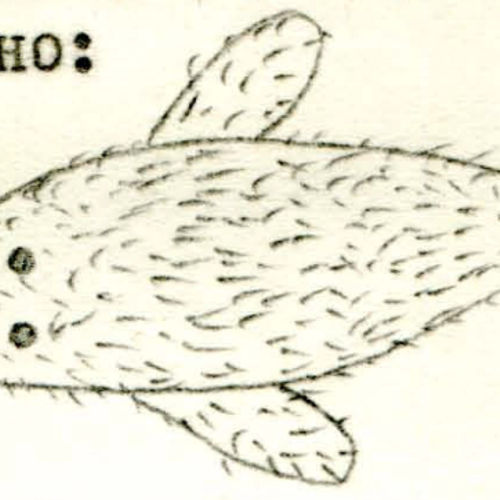
Fact #1699975518
Related news
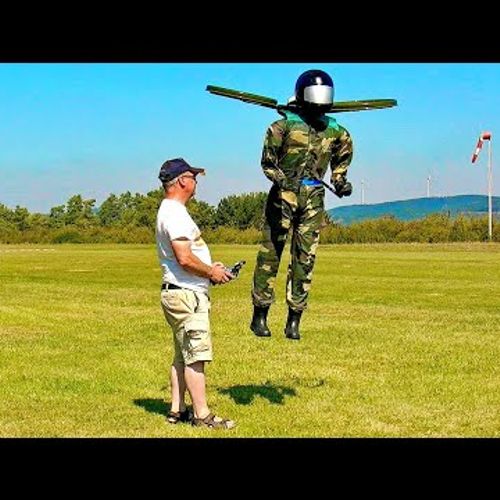
Authorities have found an explanation for flying oddities over Los Angeles
Log in or register to post comments

